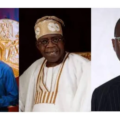By Oluwatosin Ajayi
Since the administration of former president Olusegun Obasanjo in 1999, Nigeria has experienced a series of increase and decrease in its GDP.
The Ogun-born leader served as Nigeria’s president from 1999-2006 with Atiku Abubakar, the current presidential candidate of the PDP as his vice.
Obasanjo’s regime started off with 0.58% GDP. It went on to 5.02% in 2000 and 5.92% in 2001. Obasanjo’s regime experienced the highest GDP in 2002 as it had 15.33%. In 2003, 2004, 2005, and 2006, his administration had 7.25%, 9.25%, 6.44%, and 6.06%, respectively.
When Umaru Yar’Adua came into government in 2007, Nigeria’s GDP increased from what Obasanjo left in his last year of governance. In 2007, Nigeria had 6.59%, 6.76% in 2008, and 8.04% in 2009. His last year of governance before his demise marked the highest GDP Nigeria had under his administration. Looking at the numbers, the GDP kept increasing from the start of his regime till the end. This showed the possibility of another increase in his fourth year had he not died in office.
In 2010, Yar’Adua’s vice, Goodluck Jonathan stepped in as president. Even though Jonathan couldn’t retain the 2009 GDP or increase it, there was a minimal difference in what his first year of governance recorded. The GDP moved from 8.04% to 8.01% in 2010. The GDP went on a downward slope as it was 5.31% in 2011 and 4.23% in 2012. His administration experienced an increase when the GDP hit 6.67% and 6.31% in 2013 and 2014, respectively.
Since Muhammadu Buhari began his presidency, the GDP is almost nothing to write home about. The GDP became 2.65% in 2015, -1.62% in 2016, and 0.81% in 2017. His administration had 1.92% in 2018, 2.21% in 2019, -1.79% in 2020, and 3.65% in 2021. Nigeria’s GDP under Buhari’s administration typifies a government with weak control of export, import, consumption, government spending and consumption.








